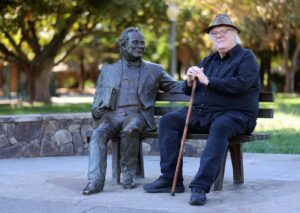
In the 1240s, Richard Fishacre, a Dominican friar at Oxford University, challenged the prevailing scientific beliefs of his time. He argued that stars and planets are composed of the same elements found on Earth, a notion that contradicted the widely accepted idea of a unique celestial material known as the “fifth element.” His insights not only questioned the orthodoxy of the medieval period but also anticipate methods utilized by contemporary instruments like the James Webb Space Telescope.
Challenging Aristotelian Views
Medieval physics, heavily influenced by the ancient Greek philosopher Aristotle, posited that celestial bodies were made of a perfect and unchanging “fifth element,” distinct from the four terrestrial elements: fire, water, earth, and air. This “quinta essentia” was thought to form the basis of the nine concentric celestial spheres surrounding Earth, with each sphere housing a planet. The outermost spheres were believed to contain the stars and heaven itself.
Fishacre, the first Dominican friar to teach theology at Oxford, rejected this theory. He believed that the stars and planets were composed of the same four elements found on Earth. His reasoning was rooted in his understanding of light and color. Fishacre observed that color is typically associated with opaque objects, which are made up of combinations of the four terrestrial elements. He noted that planets such as Mars and Venus emit light with distinct colors, suggesting that they are also composite entities made “ex quattuor elementis”—from the four elements.
His most compelling argument involved the moon, which displays a clear color and can eclipse the sun. Fishacre reasoned that if the moon were made of the transparent fifth element, sunlight would pass through it. The fact that this does not occur indicates that the moon, and by extension all celestial bodies, is made of terrestrial elements.
A Risky Proposition
Fishacre’s assertions were bold and fraught with potential backlash. He anticipated criticism from the scholarly community, famously stating, “If we posit this position, then they, that crowd of Aristotelian know-it-alls, will cry out and stone us.” His fears were soon realized when, in 1250, his teachings faced denunciation at the University of Paris by St Bonaventure of Bagnoregio, a Franciscan friar who dismissed his views as foolishness.
Today, modern astrophysics supports Fishacre’s claims. Research confirms that stars and planets are not composed of a unique fifth element but rather of many metals and materials akin to those found on Earth. For instance, the James Webb Space Telescope recently discovered high quantities of water and sulfur dioxide in the atmosphere of the exoplanet TOI-421 b, located approximately 244 light years from Earth.
Remarkably, the technique employed by the James Webb telescope, known as transmission spectroscopy, mirrors Fishacre’s methods. It detects subtle variations in light emitted by celestial bodies, revealing their chemical compositions.
Had Fishacre faced criticism for his revolutionary ideas, he would likely find satisfaction in knowing that nearly 800 years after his death, contemporary astronomy is continuing to utilize light and color to explore the elemental makeup of distant stars and planets. His pioneering thoughts laid the groundwork for future generations, reinforcing the notion that the cosmos shares fundamental similarities with our own planet.






